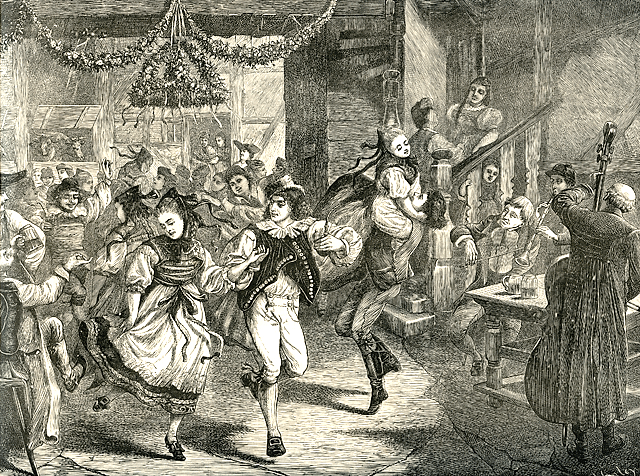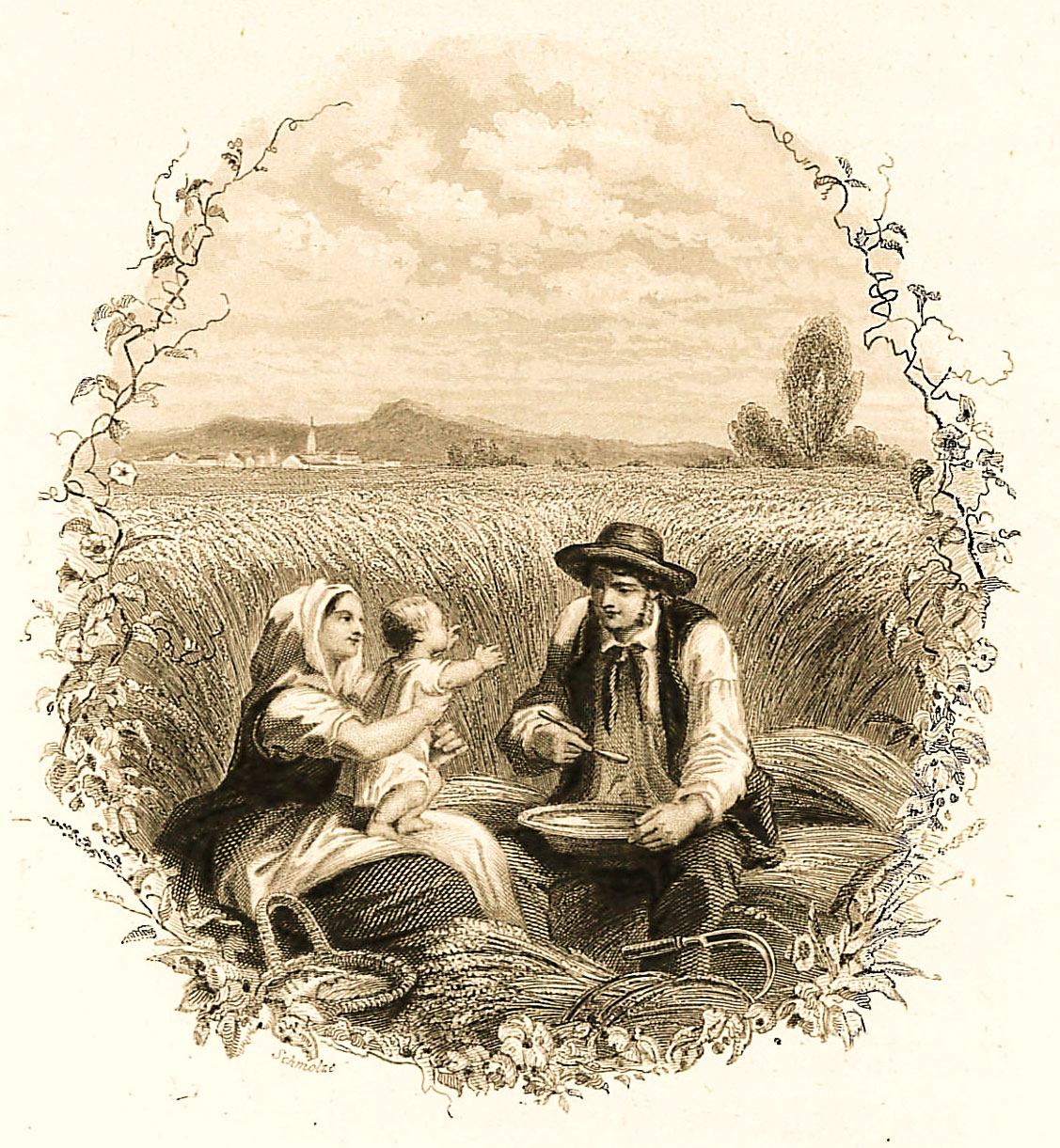Summary: Themes related to humanity’s relationship to nature as technological change led to the Industrial Revolution are evident in early modern German and Austrian art and literature. Authors of popular Hausväterliteratur (house fathers’ literature) associated with the Protestant Reformation advocated the rudiments of agricultural “improvement” through division and specialization of agrarian labor, plant selection, crop rotation, and other changes that upper class landowners adopted for their own economic benefit. By the nineteenth century, authors of Volksliteratur and Dorfgeschichten(village stories) composed novels and short stories celebrating aspects of rural culture and land stewardship as both values were increasingly threatened by modernity. In his writings on Die Gute Gesellschaft (The Good Society), Peter Rosegger cautioned against preoccupation with technical progress that was contributing to rural depopulation and erosion of the sustaining Volksgeist (folk spririt) of locale, community, and obligation.
Keywords: Protestant work ethic, rural German enlightenment, progress, folk literature
Резюме (Рихард Д. Шойерман и Артур Д. К. Эллис: «Отцы семейств» и «Люди поля» в искусстве и народной литературе со времен Реформации): Темы, которые занимаются отношением людей к природе и технологическим преобразованием в контексте промышленной революции, являются очевидными в немецком и австрийском искусстве и литературе начала нового времени. Авторы популярной литературы об отцах семейств, которые ассоциировались с протестантской Реформацией, отстаивали «улучшения» основ ведения сельского хозяйства за счет деления и специализации аграрной работы, отбора растений, севооборота и других культур, которые землевладельцы высших классов использовали только для своей экономической выгоды. До 19-го века авторы народной литературы и деревенских историй писали романы и короткие рассказы и тем самым восхваляли ценности сельской культуры и хозяйства в то время, когда этим ценностям угрожало Новое время. В своем труде «Хорошое общество» Петер Розеггер предостерегал от технического прогресса, которые способствовал уничтожению сельского населения размыванию народного духа в отношении местной и общественно-социальной ответственности.
Ключевые слова: протестантская этика труда, немецкое Просвещение на селе, прогресс, народная литература
Zusammenfassung (Richard D. Scheuerman & Arthur K. Ellis: “Hausväter” und “Menschen des Feldes” in der Kunst und Volksliteratur seit der Reformation): Themen, die sich mit menschlichen Beziehungen zur Natur und technologischen Wandel im Kontext der Industriellen Revolution beschäftigen, sind evident in der früh-modernen deutschen und österreichischen Kunst und Literatur. Autoren der populären Hausväterliteratur, die mit der Protestantischen Reformation assoziiert wurden, befürworteten die „Verbesserung“ der Grundlagen der Landwirtschaft durch Teilung und Spezialisierung der Agrararbeit, Pflanzenauswahl, wechselnde Fruchtfolge und weitere Veränderungen, die die Gutsbesitzer der oberen Klasse nur für ihren eigenen wirtschaftlichen Nutzen vornahmen. Bis zum 19. Jahrhundert haben Verfasser von Volksliteratur and Dorfgeschichten Romane und Kurzgeschichten geschrieben und damit die Werte der ländlichen Kultur und Wirtschaft gepriesen, in einer Zeit, als diese Werte zunehmend durch die Moderne bedroht wurden. In seinem Werk “Die Gute Gesellschaft” warnte Peter Rosegger vor einem technischen Fortschritt, der zur ländlichen Entvölkerung und einer Erosion des Volksgeistes hinsichtlich lokaler und gemeinschaftlich-sozialer Verantwortung beiträgt.
Schlüsselwörter: protestantische Arbeitsethik, ländliche deutsche Aufklärung, Fortschritt, Volksliteratur
That art and literature of beauty and noble truths foster moral well being is an abiding theme in the novels of Christoph Wieland (1733-1813) and the plays of Friedrich Schiller (1759-1805). Yet one searches in vain in Oberon, Schiller’s Wallenstein trilogy, or works by most other century Weimar Classicists, for agrarian scenes and experience in which these motifs are developed. Schiller’s favored poem “The Walk” (1785), however, does consider the fundamental question of humanity’s relationship to nature in the wake of civilization’s urban and technological encroachment:
O, happy People of the Fields, not yet
Wakened to freedom from the gentle will
Of the mild Nature, still content to share
With your own fields, earth’s elementary law!
Calm harvests to calm hopes the boundary set,
And peaceful as your daily labor, there
Creep on your carefree lives.
But ah! what steals
Between me and the scenes I lately saw—
A stranger spirit a strange world reveals,
A world with method, ranks, and orders rife—
And rends the simple unity of life.
The vista’d Poplars in their long array
The measured pomp of social forms betray.
… And now out the rocky kernel flowers
The haughty CITY, with its thousand towers!
(Schiller, 1887, p. 145)
Wernher der Gärtenaere’s epic poem Meier Helmbrecht (c. 1250) is remarkable for being among the earliest German literary works based on a contemporary and personal theme, and for its realistic portrayal of a farm family’s generational drama. The father, Helmbrecht and his eponymous son confront the challenges of life in the waning era of knights and chivalry, and the younger Helmbrecht’s lust for adventure leads to destructive ends in spite of his devoted father’s wise counsel. The boy’s fate is more tragic than the biblical Prodigal Son, but the story, which is set in the Bavarian-Austrian borderland, offers enriching insights into the lifeways of German farmers during the High Middle Ages.
We learn the elder Helmbrecht is a free laborer who farms a medium-sized farm on a heritable lease that he ardently hopes his son will one day assume, and that they pay a tenth of their produce, perhaps to the local monastery. The family also includes the mother and Helmbrecht’s two sisters, and all are accustomed to hard work that includes tending lost calves, feeding oxen, digging beets and cutting cabbage, beating flax, and flailing grain. The pace and labors are too much for impatient young Helmbrecht who seeks wine and “wheaten bread” instead of spring water and his mother’s soup of oats and rye, and tells his father words they both will come to greatly regret:
Now what I wish to say, please hear:
Though peasants do much work, I fear
They eat up more than is their share.
And now, however I may fare,
I certainly will plow no more!
If soiled and blackened hands I wore
Because I did the plowing here,
Then by the grace of God, it’s clear
I should be shamed, beyond all chance,
When I took the ladies’ hands in dance.
(Bell, 1931)
As with the similar genre in France, German Hausväterliteratur (“House-Father Literature”) emerged as a popular if more Protestant moralized style about rural living in the seventeenth and eighteenth centuries. Books featured informative entries on topics like crop production, raising livestock, bee-keeping, and the household economy. Many Hausväter authors were Protestant clergy whose ideas had been influenced by Martin Luther’s extraordinary German language translation of the Bible and Reformation teachings on “House Father” responsibilities as husband, parent, and manager of household and farm. Luther’s idea contributed significantly to the emergence of the Protestant work ethic that upheld work as honorable means to make yourself or find yourself.
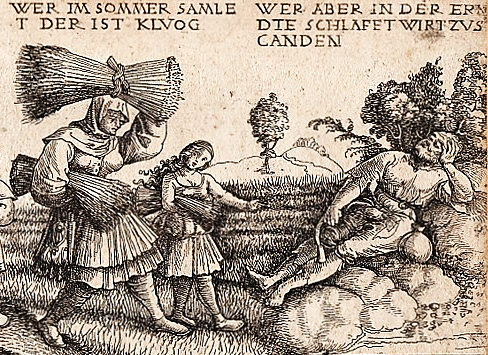
Image 1: Daniel Hopfer: Proverbs 10:4-7, Illustration (detail, 1534); (Verse 5: “He who gathers in summer is a prudent son, but he who sleeps in harvest is a son who brings shame.”) Woodcut on paper, 8 ¼ x 11 ⅕ inches; Wikimedia Commons.
Martin Luther (1483-1546) had often mentioned that he was “a farmer’s son,” and his Bible commentaries contain much agrarian imagery. In his discussion of John 6:27, for example, in which Jesus speaks with the disciples about their need for bread, Luther refers to Christ as Owner of the Granary, Baker, Brewer, and Supply; and he encourages prayer and the public reading of the Gospels in the fields to “purify the air” and that “fruit may grow vigorously.” (Luther, 1969, pp. 14-15, 90-91) The complete Lutherbibel was first published in Wittenberg in 1534 and because of the newly invented printed press copies were widely disseminated Reformation thought. Indeed, fully a third of all books printed in German during the first half of the sixteenth century were works by the reformer. Luther had high interest in using artful illumination to facilitate understanding of vernacular biblical texts, and had known the Elector of Saxony’s court painter and engraver, Lucas Cranach the Elder (c. 1472-1553), since 1504 as both men had been in Duke Frederick III’s circle of patronage.
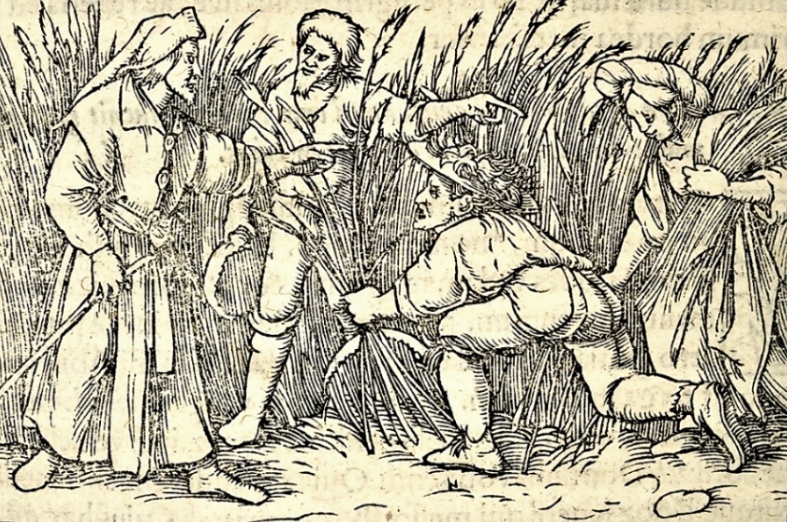
Image 2: Hans Holbein: Ruth and Boaz; Biblia Sacra iuxta Vulgatam (Paris, 1552); Adolf Bartels: Der Bauer in der deutschen Vergangenheit (Leipzig: Eugen Diederichs, 1900)
Luther and others from his circle of translator-colleagues like Phillip Melanchthon are known to have participated in the arrangement of text and Cranach’s vividly colored woodcuts of lively depictions for the first complete 1534 version. Habsburg Emperor Maximilian I commissioned Cranach and renowned German Renaissance artist Albrecht Dürer (1471-1528) to illustrate in pen the margins of a parchment Order of St. George Prayer-Book (c. 1515) that included Dürer’s drawing of the Virgin Mary with ears of wheat. Images of Maria im Ährenkleid (Mary in [Grain] Ear Dress) date to the late fourteenth century in Milan and cathedral paintings of the graceful Madonna with long blonde hair and clad in dark blue dresses adorned with golden heads of grain were popular until the Reformation. The origins of these depictions have been attributed to early church lore about the Virgin’s girlhood when she was said to have prayed for the Bread of Heaven while she embroidered clothes. In the medieval church tradition, blue represents heavenly grace and ears of grain have symbolized the spiritual nourishment and fertility of the church.i
German artist and printmaker Hans Holbein (c. 1497-1543) also provided woodcut illustrations for early editions of the Lutherbibel as well as commissioned works for Sir Thomas Moore in England and European papal princes. While his ambiguous religious convictions changed over time, Holbein is generally associated with the reformist movement and his art is considered among the supreme examples from the German reformation. As seen in his rendering of Ruth and Boaz for a Vulgate edition of the Bible (c. 1525), Holbein’s art represents a unique aesthetic in the transition from Gothic formalism to the refreshing realism in illustrations and portraiture. German printmaking is also notable for the popular “perspective” (vue d’optique) panoramas by Georg Balthasar Probst (1732-1801) and others artists affiliated in the eighteenth century with Augsburg printers that simulated three-dimensional views of Bible and historical and city scenes (Schmidt, 1977, p. 17-19, 487).
Among the most important contributors to Hausväterliteratur were the Lutheran pastors Johann Coler (1570-1639) and Franz Phillip Florinus (1649-1699). German writers like Johann Wolfgang von Goethe (1749-1832) were also known to moralize on agrarian themes in poems like “As a Man Soweth”:
We must not gather hope to be mowers,
And to gather the ripe old ears,
Unless we have first been sowers
And watered the furrows with tears.”
“It is not just as we take it,
This mystical world of ours,
Life’s field will yield as we make it
A harvest of thorns or of flowers.
(Etheridge, 2014, p. 38)
Works like the Florinus’s widely read Oeconomus Prudens (1702)were beautifully illustrated with technical drawings and engravings of threshing scenes and other field labors. One of Germany’s most acclaimed engravers and lithographers of country scenes was Johann M. Mettenleiter (1765-1853), a native of Baden-Württemberg whose early work included illustrations for Franz Marius Babo’s Paintings from the Life of the People (1784) and Lorenz von Westenrieder’s History of Bavaria (1786). Mettenleiter became a founding member of the Munich Kunstverein where he improved lithographic processes of the time which led the wider distribution of his workmanship and noble patronage. In 1790 Elector Karl Theodor of Bavaria appointed Mettenleiter as his court engraver, and Russian Tsar Alexander I subsequently commissioned him to complete a series of engravings of his country estates in St. Petersburg and awarded him the Imperial Order of St. Stanislas. Mettenleiter’s distinctive compositions that depict both country labor and aristocratic life are evident in his 1788 woodcut, Lords and Reapers Celebrate Harvest.
![Image 3: (Left) Albrecht Dürer: “Mary in [Grain] Ear Dress” (c. 1515). Randzeichnungen zum Gebetbuche des Kaisers Maximilian I (München, 1907); (Right) Maria im Ährenkleid (c. 1490), Bayerisches Nationalmuseum, Salzburg.](http://www.ide-journal.org/wp-content/uploads/2017/04/IDE-2-2017-7-Scheu.-Ellis-Image-04.png)
Image 3: (Left) Albrecht Dürer: “Mary in [Grain] Ear Dress” (c. 1515). Randzeichnungen zum Gebetbuche des Kaisers Maximilian I (München, 1907); (Right) Maria im Ährenkleid (c. 1490), Bayerisches Nationalmuseum, Salzburg.
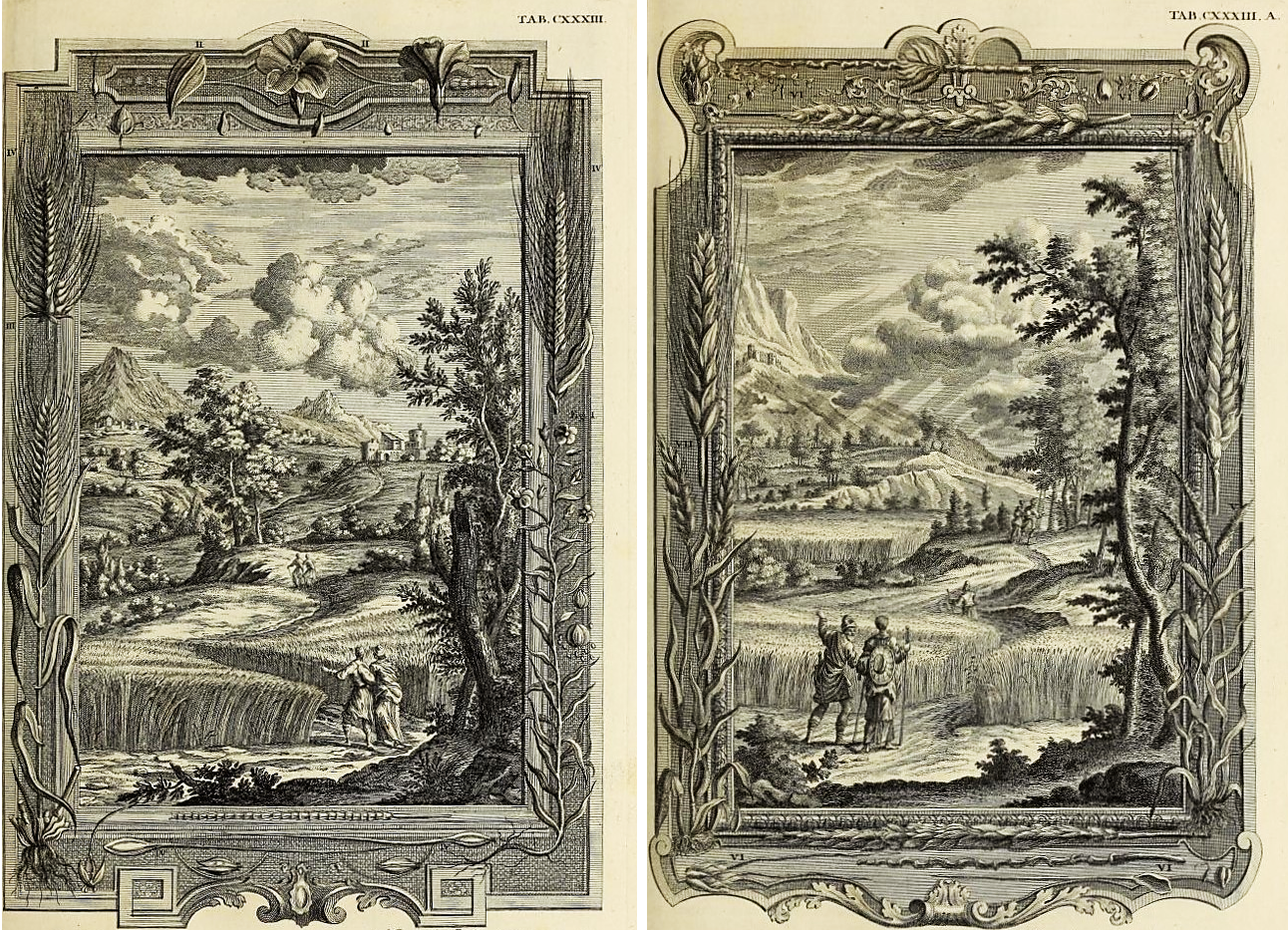
Image 4: J. Fredrich: Flax and Barley (Exodus 9: 31); M. Tyroff, Emmer and Wheat (Exodus 9:32). Copper-plated engravings on paper, 10 ¼ x 16 inches; Johann Scheuchzer, Physica Sacra (1731-1735).
Scheuchzer’s chronological commentaries included numerous references to plants and animals of the Bible in illustrated stories from both Old and New Testaments involving crops and ancient field operations. Scheuchzer supervised all aspects of the series’ production and entrusted Nuremberg Academy of Fine Arts director Johann Daniel Preissler (1666-1737) with the design of elaborate frames unique to each illustration which was also included reference to a specific Bible verses. In the case of engravings related to the Exodus account of the plague of hail upon Egyptian crops (Genesis 41), Gideon’s threshing floor (Judges 6:37), Elisa’s miracle of the bread (II Kings 4:42), and Jesus’ parables (e. g, Matthew 13), these borders contain detailed close-up views of threshing tools and heads of flax, grain, and other crops familiar to early eighteenth century artists. But Preissler’s horned straw pitchforks did not appear until medieval times and his rendering of emmer looks more like German spelt, a separate primitive wheat species The bushy branching heads of a peculiar club wheat (Triticum vulgare compactum, German “Miracle wheat”) prominently displayed at the base of the “Pharoah’s Dream” (Genesis 41), however, are a variety native to Egypt. These detailed imaginative views in the Kupfer-Bibel attest to the significance of agrarian imagery in minds of Scheuchzer’s many readers. (Van Berkel & Vanderjagt, 2006, p. 115-116)
Agrarian associations with German Enlightenment thought is also evident in the writings of Augsburg’s Gottlieb Tobias Wilhelm (1758-1811) and poet and pedagogue Christian Felix Weisse (1726-1804) of Leipzig. Wilhelm was a Protestant pastor and natural philosopher who contributed nineteen of twenty-five volumes in the magisterial Discourses in Natural History published from the 1790s to 1810 by his father, Christian Art Wilhelm, with hundreds of hand-colored copperplate engravings by Jacob Xaver Schmutzer (1713-1775) and Balthasar Friedrich Leizelt (1855-1812). Wesse tutored children of the nobility and edited the influential journal Bibliothek der schönen Wissenschaften und der freyen Künste (Library of the Beautiful Sciences and Liberal Arts) for three decades beginning in 1759. Weisse criticized extravagance in literature and became a popular children’s author of stories that blended religious piety with regional folklore, and published a pedagogical weekly, Der Kinderfreund (The Children’s Friend), the first periodical for children in German. As in his poem “After the Harvest” (“Nach der Ernte”), many of Weisse’s stories and poems served to impart young and old alike with appreciation for country life throughout Saxony.
The fields around all empty lie,
Our barns are stored with grain,
And joyfully we homeward hie,
And bring our labor’s gain.
Lovely field, when Spring around
Has flung her verdue bright,
When May spreads flowers on the ground,
And trees are blooming white.
But lovelier far the golden wheat
That springeth from the soil,
That bows the head as though to greet.
With thankfulness our toil.
On wagons, ‘neath their golden weight
That groan, our maidens ride,
The while, with honest joy elate,
Our reapers march beside.
(Dulcan, 1856, p. 250)
Rural themes in Continental literature further developed into the nineteenth century Volksliteratur (folk literature) and Dorfgeschichte (village tales) of Swiss writer Jeremias Gotthelf (1797-1854), Germans Fritz Reuter (1810-1874) and Berthold Auerbach (1812-1882), and Austrian novelist and poet, Peter Rosegger (1843-1918). Writing in the Low German dialects of country people, these popular writers composed colloquial verse, humorous short stories, and adventuresome Bauernroman novels of local flavor that idealized some aspects of peasant life while presenting frank depictions of the rural poor. Julian Schmidt, a literary critic of the time, observed that these writers keenly conveyed their characters’ personal enjoyments alongside internal dissensions common to village life through the hearty openness of peasant conversation. (Schmidt, 1865, p. 171)
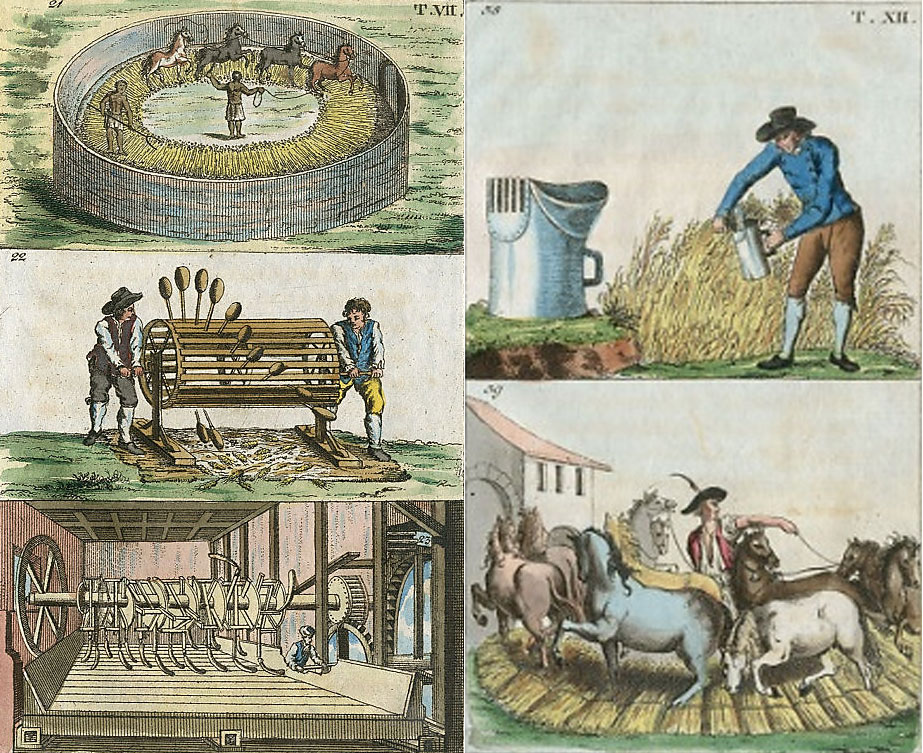
Image 5: Attributed to Jacob Xaver Schmutzer, “Methods of Threshing and Flailing Grain”; Hand-colored engravings, 3 ¾ x 6 ½ inches; Gottlieb Tobias Wilhelm: Unterhaltungen aus der Naturgeschichte (Augsburg, 1810).
Gotthelf’s Uli der Knecht (Ulrich the Farm Servant, 1841), translated into English by John Ruskin, is the story of a poor farmer who struggles to learn newer methods of cultivation to transform his meagre holdings into a thriving enterprise. He seasonally hires out to more prosperous Bernese neighbors to sharpen scythes and tend livestock. He partakes of harvest feasting where, “Even the most callous [landowners] feel some sentiment of thankfulness towards God, and understand that they owe Him some offering as an expression of their gratitude. …Should not habitual thanksgiving be the result of so much bounty?” (Ruskin, 1907, p. 452) Reuter, who was jailed as a young man for political activism, wrote the three-volume novel Ut mine Stromid (1862-1864), published in English as Seedtime and Harvest (1872) and From My Farming Days (1878), which describes with hints of Dickens-like caricature the peasant farmers and villagers of his native Mecklenburg.
One of the most influential Dorfgeschichte writers was the German-Jewish poet and Swabian novelist Berthold Auerbach, author of the immensely popular Schwartzwälder Dorfgeschichten (Black Forest Village Tales,1843), published in English in 1869 as Black Forest Village Stories. In the eponymous tale “Lauterbach,” Auerbach tells of the young country schoolmaster who finds work patiently tending the youth of Nordstettin. As a result of Lauterbach’s after-school countryside ramblings, readers are shown his “Wisdom of the Fields” notebook that records personal reflections and relates coarse-grained peasant harvest lore and provincial expressions to lessons for life:
- In cutting grain, the reaper must lay the swath behind him, so as to have nothing before him but the blades still standing. So with the deeds that we have done. They must be out of sight, so that all our attention may be turned to what yet remains to do.
- When in the distance I see mowers bowing and rising so regularly, it seems as if they were going through some ceremonious ritual of prayer.
- The weeds in the grain-fields are no man’s property until the poor take them away and convert them into nutritious food. Do you ask, of what use are weeds? Perhaps many other things should be judged by the same rule.
- Every patch of ground has its history. Could anyone unravel the mutations which transferred it from hand to hand, and the fortunes and sentiments of those who tilled it, he would understand the history of the human race… (Auerbach, 1869, p. 321-328)
One of the Austria’s most beloved authors, Heimatdichter (homeland poet) Peter Rosegger fashioned lively novels, short stories, and poetry deeply influenced by his experiences as a farm youth and devout country schoolteacher in the rural southeastern Tyrolian highlands. Critics praised such works as Volklieben in Steiermark (Folklife in Styria, 1871), his semi-autobiographical Waldheimat (The Forest Farm, 1877), and epistolary novel Erdsegen (Earth’s Blessing, 1900) for their lyrical yet unsentimental representations of land-folk that combined humor and ill-fortune. Rosegger’s country characters live between worlds ancient and modern and confront challenges of the day in stories rich with rural proverbs, folksongs, traditional remedies, and culinary lore. Europeans who perceived growing urban pretentiousness found in Rosegger’s works meaningful expression of Die Gute Gesellschaft (The Good Society) where dignity and respect for others and nature were informed by tradition and religious belief. Personal autonomy celebrated by avant popular culture offered a choice of risk divorced from the stabilizing, meaningful Volksgeist humus of locale, community, and obligation. By 1905 Rosegger’s books had been translated into twenty-two languages; in 1913 he received the Nobel Prize for Literature and became the most widely read German author of his day. Details of agronomy and nature woven into Rosegger’s prose reflect intimate knowledge of farm life, as evident in the observations of Waldheimat farmer “Jakob der Letzte”:
Before him the brown fields stretch away, the larks blow their trumpets, and in tender, reddish blades the dead arise and look up to heaven. Then gradually everything begins to grown green, the tiny leaves curl and bend earthwards again as if they are listening for any counsels about life that the Mother may give to them. Then they aspire upwards, rolling themselves into sheaths, out of which, little by little, emerges the stalk and the inmost being of the grain. … And the single blade is now in its full glory. The four-sided ear, in which the still tender grains lie scale-like over each other, hangs its blossom out like tiny flags wherever a grainlet lies in its cradle, which flutter and tremble without ceasing, while the high stalk rocks thoughtfully to and fro.
… Strong and slender the stalks grow up from joint to joint. The lance-shaped, dark green leaves that lorded it at first, have nearly vanished, the stalks droop their heavy heads, which give back the sown grain thirty or forty-fold, one stalk laying its golden head on the shoulder of another. In the sun’s heat by day, at night in the light of the moon and the stars and the glimmer of glow-worms, they are ripening towards harvest. …When Jacob, always first and last in the heat and burden of the day, rests in late evening beneath a grain-stook in the harvest field, his dreaming begins again. The breath of grass and flowers makes him drowsy: he watches the antics of a jolly grasshopper, hears the chirp of a cricket—then it all fades away. He is looking out over a country where there is no blue forest, no green meadows, no mountain crags, and no clear streams. So far as ever the eye can reach is one great golden sea, an immeasurable field of grain. (Rosegger, 1912, p. 194-195)
Northern Landscapes, Biedermeier, and Music of Harvest
The 1815 Congress of Vienna had brought peace to a rising European middle class long weary of Napoleonic devastation. Latent desire for domestic tranquility following so many years of foreign interventions restored the vitality of regional cultures and led to renewed appreciation for contentment through the simple life. The martial grandeur evident in public events and fine art of galleries in Berlin, Mainz, and Vienna gave way to a half-century of introspection during which many artists and designers found meaning in more sentimental expressions of community Gemütlich and personal piety. Biedermeier furniture designers used locally available cherry, ash, and oak instead of the imported mahogany formerly preferred by homeowners to construct unique designs featuring straight lines and panels often colorfully decorated with unpretentious designs inspired by peasant folk art.
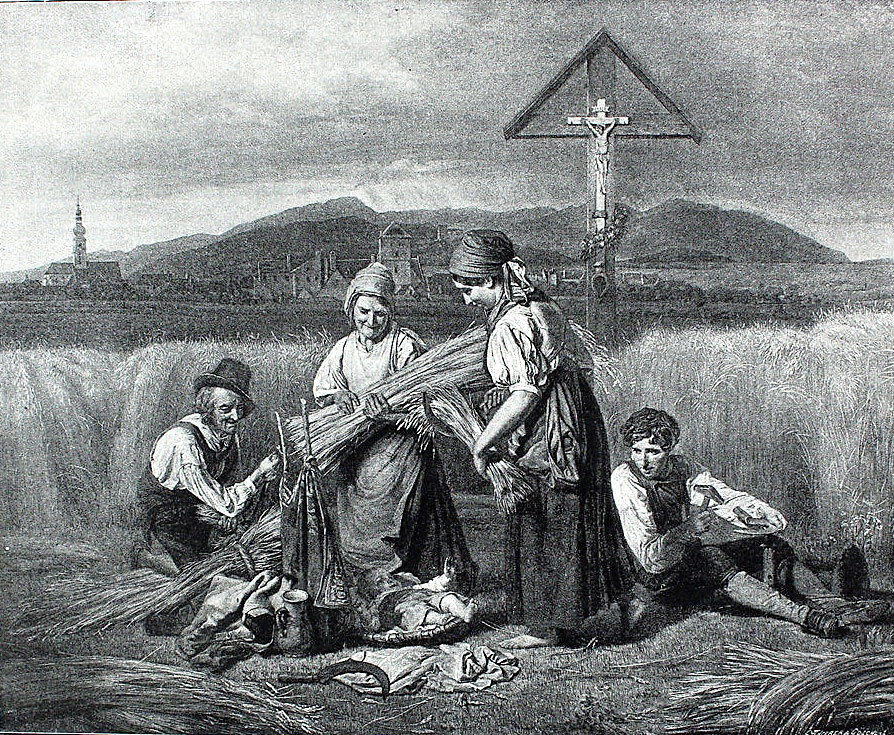
Image 6: After Ferdinand Waldemüller: The Harvest (1847). Lithograph on paper, 7 ½ x 9 inches (1887). Palouse Regional Studies Collection.
Influential Biedermeier artists, named for the pseudonym used by a pair of Munich area poets, included the Austrian painters Ferdinand Georg Waldemüller (1793-1865) and Friedrich Gauermann (1807-1862), who painted detailed harvest scenes after summer visits to the hinterland. Waldmüller’s blissful The Harvest (1847) appears to show a foursome of parents and grandparents smiling at a child who lies contentedly in a basket. The trappings of harvest field labors surround the group with the women clutching grain while the elderly man ties a sheaf and the younger sharpens a sickle with a peening hammer. A field crucifix is prominently mounted on a post behind them, and a church steeple is visible in a distant village. Some Vienna Successionists later praised Waldmüller for introducing a new kind of atmospheric realism through his naturalistic plein air coloring technique. Friedrich Gauermann’s Harvesting in the Foothills of the Alps (1835, issued as a popular lithograph by Vienna’s Austrian Kunstverein as The Harvest)and The Harvest Wagon (1837) are notable for imposing skyscapes that seem to frame the colorfully clad peasant workers in a dramatic nobility of the countryside. The latter painting, in the Liechtenstein Princely Collection, shows three horses straining to pull a wagon heavily laden with grain uphill as a furious storm rolls in from mountains in the distance. The viewer is drawn to the vital struggle of life near Lake Zellar in central Austria and the likelihood of deliverance. No marching army could be more heroic. (Dow & Sandrock, 1976)
Classical and Romantic composers of the period found inspiration in popular folk tunes surely known to rural subjects of their contemporaries’ harvest landscape paintings. Austrians Joseph Haydn (1732-1809), Wolfgang Amadeus Mozart (1756-1791), Franz Schubert (1797-1828), and Franz Liszt (1811-1886) are known to have delighted in the familiar tunes of Viennese ballads, Tyrolean folksongs, and other melodies that are heard as elaborated segments in many of their orchestral and choral works. Mozart set to music German lyrical poet Ludwig Christoph Heinrich Hölty’s “The Old Farmer to His Son,” a succinct expression of Prussian rural values, in his 1791 opera The Magic Flute; and Liszt’s stirring “Reapers Chorus” (Schnitterchor) from his symphonic poem Prometheus Unbound (1850) left audiences cheering for encores as if the overture’s harvesters were lauding the gift of fire to humanity. In 1816, Franz Schubert set Hölty’s Ernteliedii(Harvest Song, 1773) to a lively four-part strophic setting of the same title for one of his few contrapuntal songs. One can hear the reapers’ scythe swing in the poem’s onomatopoeic opening lines that scarcely need translation (“Sicheln schallen, Ähren fallen…”) and continue with a simple story that concert audiences of the day found entertaining and might well have been heard in summertime grain fields along the Donau:
Sickles sound;
On the ground
Fast the ripe ears fall;
Every maiden’s bonnet
Has blue blossoms on it;
Joy is over all.
Sickles ring,
Maidens sing
To the sickle’s sound;
Till the moon is beaming,
And the stubble gleaming,
Harvest songs go round.
All are springing,
All are singing,
Every lisping thing.
Man and master meet;
From one dish they eat;
Each is now a king.
(Reed, 1997, p. 224)
Akademien, Malerkolonien, and Americans Abroad
By the mid-nineteenth century, patrons of the arts in Germany experienced a range of aesthetic styles variously influenced by regional responses to Romanticism and Biedermeier as well as by foreign trends. Berlin, Düsseldorf, Frankfurt, a. M., Munich, and other major German cities hosted academies that became generally known for interpretations of nature and society through new approaches to subject, color, and composition. Jakob Becker (1810-1872) studied at the Düsseldorf Academy from 1833 to 1841 where he mastered the finely detailed if fanciful landscapes and genre subjects for which the school became known and which significantly influenced many prominent American Hudson River painters. Following his studies in Düsseldorf, Becker began his three-decade tenure as the first professor landscape and genre painting at the Städel in Frankfurt, and sought out rural subjects in order to depict with both realism and emotion the social conditions of the peasantry. Among his most famous works are the harvest and family-themed paintings Reapers Fleeing a Thunderstorm (1840), which shows workers’ responses to the fearsome prospect of a grainfield fire, and joyous Homecoming of the Reapers (1847).
Munich native Karl Theodor Piloty (1826-1886) painted grand scenes from German history and inaugurated a generation of realist artists following his appointment in 1856 as professor at the influential Munich Art Academy. One of his most notable protégées, Theodor Schütz (1830-1900, sometimes “Schultz”) studied at the school from 1857 to 1863 and frequently painted central German and Italian country scenes while traveling with Piloty and other academy artists. Schütz’s brilliantly colored, naturalistic canvases like Midday Prayer in the Harvest (1861) and Evening Landscape in Harvest (1879) depict some of the era’s most evocative scenes of German country life. The Munich Academy also influenced William Merritt Chase, Walter Shirlaw, and other American artists who studied under the tutelage of Piloty, Karl Otto, and others prominent German artists.
One of Piloty’s and Schütz’s most notable students, Albert Kappis (1836-1914), was a prodigious painter and printmaker from Stuttgart who favored genre themes and rural landscapes that included numerous harvest and haying scenes. Kappis traveled to Barbizon in 1867 and many of his subsequent works anticipate Impressionism through use of a Swabian earth tone palette to depict scenes of peasant labor in such paintings as Harvesting (1871), Harvest Time (1871), Stuttgart Harvest (1878), and Children at a Harvest Festival (n.d.). Artistic fidelity to Volksgeist agrarian and religious values is also seen in the work of such regionalist painters of the time as Hans Thoma (1839-1924), and though trained at prestigious art academies in Düsseldorf and Karlsruhe, where he later taught, his heart and imagination never strayed far from the Black Forest settings of his youth. The prolific Thoma credited the sixteenth century influence of Lucas Cranach the Elder more that the modern masters with whom he studied. His many robust biblical scenes and naturalistic poetic of Baden-Württemberg and Hessen were prized by galleries and collectors throughout Europe. Thoma’s colorfully placid depictions of harvest time labors, often amidst intricately painted foliage of trees and forbs, include Ripened Grain, Summer in the Black Forest (1873), Grainfield in Ears (1883), and Grainfield by Oberusel (1902).
Pittsburg’s Charles Stanley Reinhart (1844-1896) studied in Munich and Paris in the 1880s and returned home to become a leading figure in America’s Golden Age of Illustration. Willa Cather (Lincoln Courier, October 23, 1897) wrote that Reinhart depicted “the dignity and tragedy of labor” in the many scenes he supplied to illustrate Harper & Brothers publications and novels by European authors. One can sense the heat, exhaustion, and noise in his spirited scene, Primitive Thrashing, which shows a man straining with a taut rope to guide a team of horses around in a circle as they pull a threshing sled weighed down by a woman who holds on dearly to a wooden brace for support and balance.
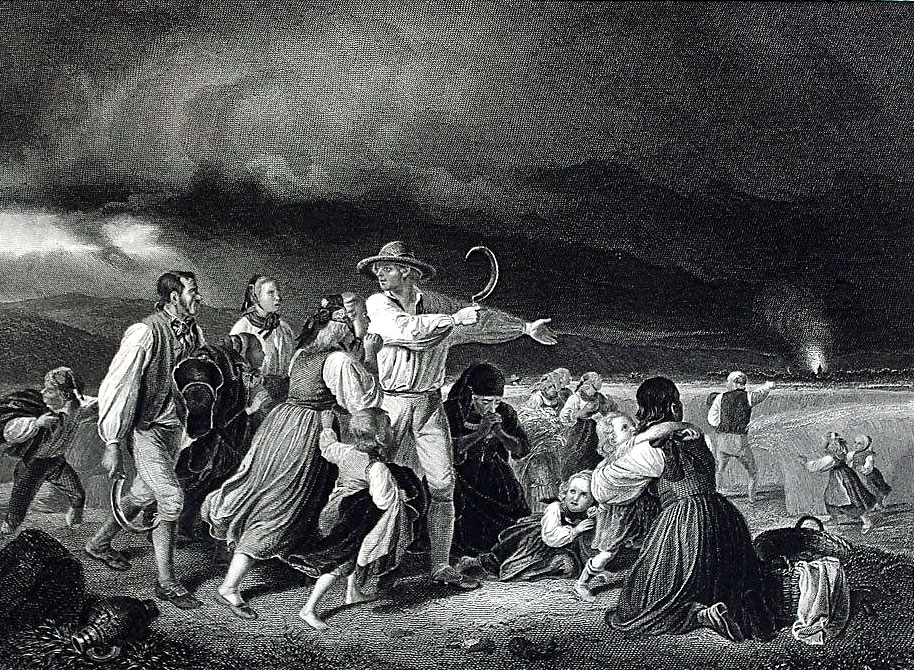
Image 7: After Jakob Becker: Reapers Fleeing a Thunderstorm (1840). Engraving on paper, 5 x 7 inches (1860); Palouse Regional Studies Collection.
Popular American travel writer Bayard Taylor (1833-1908) traveled extensively throughout Europe in the 1850s, became fluent in German and Swedish, and served from 1862 to 1863 as U. S. Minister to Russia. His many published travelogues make frequent mention of rural life on the continent. His descriptions of harvest time in a chapter from Byways of Europe from an 1856 journey through Thuringian in central Germany speak to aesthetic associations with place and people, and understanding of poetry’s source as both senses and imagination:
I went to northward from Gotha into a boundless, undulating region of tawny harvest and stubble fields. The plain behind me, stretching to the foot of the Thuringian Forest, was covered with a silvery, shimmering atmosphere, on which the scattered villages, the orchards, and the poplar-bordered highways were dimly blotted, like the first timid sketch of a picture, which shall grow into the clear, confident color. Far and wide, over the fields, the peasants worked silently and steadily among their flax, oats, and potatoes,—perhaps rejoicing in the bounty of the sunshine, but too much in earnest to think of singing. …Wains, laden with sheaves, rumbled slowly along the road towards the village barns. I had nothing to do but watch the mellow colors of the broadening landscape, as we climbed the long waves of earth, stretching eastward and westward out of sight. Those mixed, yet perfect moods, which come equally from the delight of the senses and the release of the imagination, seem to be the very essence of poetry… (Taylor, 1864, 323-324)
In the same vicinity Taylor also recorded a familiar German Harvest-Home custom:
The field-laborers on my friend’s property commemorated the close of the season by bringing him, according to custom, an Erntekranz (harvest-wreath) of ripe rye and barley-stalks, mixed with wild grasses and adorned with fantastic strips of colored and gilded papers. This wreath was formally delivered to the landlord, who also, according to custom, regaled the laborers with plum cakes and wine. They passed the afternoon and evening in one of the outer rooms, settling their accounts and partaking of the cheer, after which a gittern was brought forth and room cleared for a dance. We had some of the old Thuringian songs, with a chorus more loud than musical, and two-step waltzes danced to the tinkling gittern.iii (Taylor, 1864, 323-324)
One of Germany’s most prolific painters of harvest and haying scenes, Hugo Mühling (1854-1929), was born in Dresden to a family of prominent landscape artists. He became a seasonal participant in the country’s oldest art colony, the Willingshäusen Malerkolonie, which had been established in the picturesque Hessian village north of Frankfurt, a. M. surrounded by rolling hills and valleys bathed in a liquid light that had long attracted artists to the area. Colony founder and Baltic German Gerhardt Wilhelm von Reutern (1794-1865) came to Willingshausen to recover from serious injuries he had suffered as a commander in the Russian army at the 1814 Battle of Leipzig. The Romanov family provided von Reutern a stipend and with encouragement from Goethe and Emil Lugwig Grimm, the third of the brothers Grimm, he decided to remain in the area and become a painter of local inhabitants and scenes. Subsequent artist visitors to the area like Jakob Dielmann (1809-1885) and Ludwig Knaus (1829-1910) further popularized the location which in turn attracted a later generation of painters like Mühling. Many of these later colony artists painted plein air renderings of summertime field labors though few, in any, completed as many harvest and haying scenes as did Mühling whose works (c. 1885-1905) include The Grain Harvest, Prayers in the Grainfield, The Harvest Sheaves, and Farmers in Harvest.iv (Taylor, 1871, p. 310-311)
Dresden emerged as an important center for German Expressionist art with the formation in 1905 of the Die Brücke (The Bridge) Group by Fritz Bleyl (1880-1976), Eric Heckel (1883-1966), and several others who had no formal training in art but valued intuition and fresh perspectives to interpret a changing world. These bohemian artists sought to assert the inspired printmaking and painting styles of Dürer and Lucas Cranach the Elder and appropriate new ways of depicting meaning in the spirit of Van Gogh and Kandinsky without the constraints of academic conventions. Similar movements soon arose in Munich, Berlin, and other German cities where writers and artists sought to express their perceptions of troubling social and political trends that contributed to a sense of alienation from the natural world and preoccupation with material values.
Expressionists like Heckel, Eric Nolde (1867-1956), and Munich’s Franz Marc (1880-1916) and Ludwig Zumbusch (1861-1927) looked to the inner self for a psychological oeuvre of personal interpretation depicted not in external visual reality, but in flowing forms and rich colors as seen in Zumbusch’s placid Harvesters. Nolde drew from his rural upbringing in northwestern Germany for such paintings as Harvest Day (1904), a vivid composition of unlikely greens and yellows with splashes of mauve that swirl around a team of rakers as if they are fighting back the tide. The painting caused a sensation when exhibited in Berlin two years later as viewers experienced invigorating if somewhat vertiginous feelings of prospect for the new century. Marc’s more soothing depiction of harvest in Sheaves of Grain (1907) with soft yellow stalks against a placid sky of lavender and gray is strongly reminiscent of Van Gogh, and expresses his appreciation for agrarian ways and rhythms of nature.v
* * *
The Reformation, following on the Renaissance, takes its place as one of the great disruptive innovations in European and world history. The radical, world-changing work of such giants as Luther and Melanchthon was made possible because of advances in the arts, sciences, and technology, among them the printing press which made possible individual access to both salvation (religion) and literacy (education). Other technologies followed on, changing the shape of things to come from predominantly agrarian and pastoral to industrial and urban. In this essay we have attempted to capture an image of something largely lost, the hallowed harvest.
References
- Auerbach, Berthold (1869): Black Forest Village Stories. New York: Leypoldt & Holt.
- Bell, Clair Hayden (1931): Peasant Life in Old German Epics: Meier Helmbrecht and Der Arme Heinrich. New York: Columbia University Press.
- Dow, James R. & Sandrock, James S. (1976): Peter Rosegger’s ‘Erdsegen’: The Function of Folklore in the Work of an Austrian Heimatdichter. In: Journal of the Folklore Institute, vol 13, Nr. 3, Special Issue, pp. 227-239.
- Dulcan, Henry William (1856): The Book of German Songs. London.
- Etheridge, Samuel N. (Ed.) (2014): Poetry for a Lifetime. Orinda: Miravista Press.
- Luther, Martin (1969): Luther’s Works, Vol. 42. St. Louis: Concordia Publishing House.
- Reed, John (1997): The Schubert Song Companion. New York: Manchester University Press.
- Rosegger, Peter (1912): The Forest Farm: Tales of the Austrian Tyrol. London: A.C. Fifield
- Schiller, Friedrich (1887): Schiller’s Poems and Ballads. London: George Routledge and Sons.
- Schmidt, Julian (1865): Geschichte der Deutschen Litteratur seit Lessings Tod. Leipzig: F. W. Grimow.
- Schmidt, Phillip (1977): Die Illustration der Lutherbibel, 1522-1700. Basel: Friedrich Reinhardt Verlag.
- Taylor, Bayard (1864 / 1871): Byways of Europe. New York: G. P. Putnam and Son.
- Van Berkel, Klaas & Vanderjagt, Arjo (Eds.) (2006): The Book of Nature in Early Modern and Modern History. Leuven: Peeters, Bondgenotenlaan.
About the Authors
Prof. Dr. Richard D. Scheuerman: Associate Professor of Curriculum and Instruction, Seattle Pacific University, Seattle, WA (USA). Contact: scheur@spu.
Prof. Dr. Arthur K. Ellis: Professor of Education, Director of the Center for Global Curriculum Studies, Seattle Pacific University, Seattle, WA (USA). Contact: aellis@spu.edu.
Endnotes
i Cranach’s woodcuts were reworked in later editions of the Lutherbibel by other prominent German artists including Christoph Murer (1558-1614), and Paul Creutzberger (1539-1591). Other fifteenth century portrayals of Maria im Ährenkleid are in the Bavarian National Museum, Munich; State Pushkin Museum, Moscow, and St. Mary’s Church, Budweis, Czech Republic. Luther also sought to refocus spiritual attention to obligations that had become increasingly secularized and decried, for example, the “disgraceful babble and hilarity” of village processions and raucous outdoor festivals that took place during Rogation Week. Observed since at least the sixth century, Rogate Sunday was to begin a time of fasting and abstinence in anticipation of Ascension Sunday in April or May, and was associated with the annual “Blessing of the Fields” ceremonies which signaled the beginning of springtime planting.
ii Schubert’s Erntelied score is found in Franz Schubert’s Werke, Serie XX: Säintliche Lieder und Gesänge (Leipzig, 1894-1895). The exuberant The Four Seasons concerto series (c. 1723) by Italian composer Antonio Vivaldi (1678-1741) is the Baroque composer’s most famous work and was influenced by his viewing the seasonal landscapes of Marco Ricci (1676-1730). Published in 1725 with accompanying sonnets likely written by Vivaldi himself, The Four Seasons is one of the first-known examples of program music which features narrative elements relating text to music to better inform listeners. His third concerto in the Seasons series, “Autumn” (No. 3 in F major, Op. 8, “L’autunno”) includes verse that explicitly relates the music to “the pleasure of the rich harvest.”
iii A gittern is a small guitar-like instrument.
iv In his later years Mühling became a prominent figure in the Düsseldorf Successionist movement. Notable German scientists of the time also contributed to documentary botanical art featuring cereal grains. Among the most notable publications that contains hundreds of color lithographs is Flora von Deutschland, Österriech und der Schweiz (1885), the ambitious four-volume work by Otto Wilhelm Thomé (1840-1925) of Cologne.
v Marc’s Sheaves of Grain (Getreidegarben) is in the collection of Iowa City’s University of Iowa Museum of Arts which also contains Expressionistic works by Gabrielle Münter and Wassily Kandinsky.

